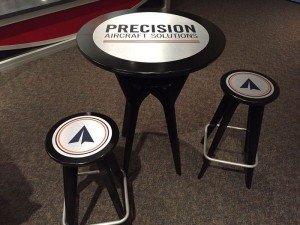Ten Questions Guaranteed To Fine Tune Your Trade Show Strategy
Remember how satisfying it felt when you fiddled with the car radio dial and finally got your station to come through loud and clear? No static, no bleed-through from another broadcaster—just the program you wanted to listen to, sounding clear as a bell. That’s what fine tuning does: it wipes away the static and noise, and allows you to focus on what’s important.
There are plenty of ways to approach thinking about your trade show strategy that lead to fuzzy, indeterminate results. Ultimately, following any of those paths leaves you with a trade show marketing program that doesn’t communicate as clearly as it could, doesn’t cut through the clutter and noise on the trade show floor, and doesn’t position your company in its best light.
To get a clearer picture of how you want your trade show strategy to work, I suggest you ask yourself—and those who have a stake in your organization’s trade show program—these ten questions, and keep your answers 100% honest. You might be surprised at what they reveal when you’ve completed the process.
1. Will this exhibit promote a new company, idea or product?
If you’re new, your objective should be to build awareness about your company. If the idea or concept you’re promoting is new, think about the specific market or audience that will be most receptive to this concept, and concentrate on how you can reach them. If the product is what’s new, you don’t want attendees passing by your exhibit, thinking they’ve seen it all before. Give them a reason to stop and see what’s new.
2. Where is your company positioned within the industry?
Maybe you’re an established and well-regarded brand. Or you might be a start-up that’s almost completely unknown. Knowing where you stand in comparison to your competition will help you determine how to play to your strengths.
3. Which of your product’s features and benefits do you want booth visitors to know about?
You might end up with a long list, and you’ll have to trim it down to align with the realities of time available for product demos, space in the booth for the products and their related graphics, and other variables.
3.5 Focus on the top 3-5 points you want to communicate, then follow the:
- Tell ‘Em What You’re Going To Tell ‘Em,
- Tell ‘Em, then
- Tell ‘Em What You Told ‘Em
formula for sharing information.
4. What sales volume can you forecast for the product, its markets and geographic areas?
Most of all, the answer to this question will tell you whether trade shows are the best way to market what you’re selling. Can you foresee enough revenue from the shows to warrant doing them? Can you find shows that reach the markets you expect your product to do well in?
5. What are your market’s buying habits, preferences and needs?
Your answer to this question will literally help you fine tune your approach to the market with your offering, price, and the features and benefits you’ll highlight. This will also give you clues about what actions you’ll want your booth visitors to take at the show (write an order, ask for a site visit, request more information, etc).
6. Why should customers buy from you?
Your answer will shine a spotlight on the biggest benefits of your product or service and the way you do business. Make sure everyone (and I mean everyone) staffing your display knows what separates you from the competition.
7. What are your competitors’ strengths and weaknesses?
Answer this, and you’ll know what you’re up against. It can also have an effect on your messaging. For example, you may choose to focus on a known strength for your product versus a known weakness for your competitor’s.
8. How will you measure this particular show’s success?
You may have different metrics for each show you attend, but knowing how you’ll score this one will affect what information you collect at the show. You also want your staffers to know the answer to this question, so they can harness their efforts in ways that support your overall goals.
9. What are your goals and objectives?
Both short term and long term, how does this show fit into your overall marketing strategy? Knowing your overall objectives helps you get the most out of each show, while staying focused on the bottom line.
10. How will your performance be evaluated?
You may do a great job pulling off a successful show. But if management was only interested in profits, how smoothly the show went may not make a dent in their analysis. If you know how you’re going to be judged, you can plan, execute and document your actions to make the best of the situation.
Nothing helps you pull off a successful show more than having a solid partner working with you each step of the way. Whether you need simple graphics changes from show to show, or a last minute save-the-day rescue, we’ve done it all. And we continue to be focused on helping our customers succeed. Whatever your needs, let professionals with experience, expertise and heart help you do your job better. For more information, call us at (425) 556-9511 or email [email protected].
For more, check out the ways you might be losing money or check out upcoming trade shows.
[optin-monster-shortcode id=”kgycuhbazh-post”]
